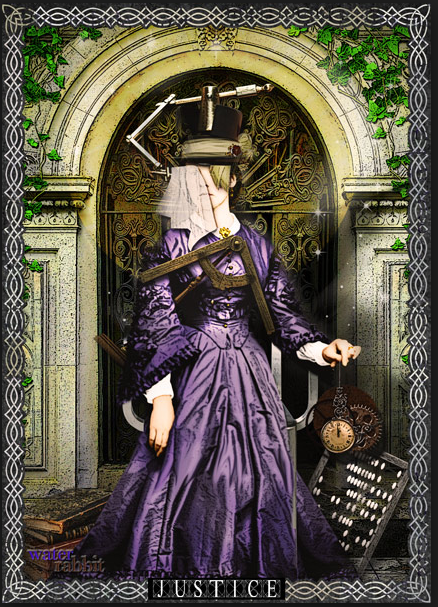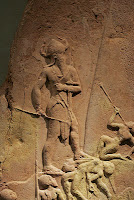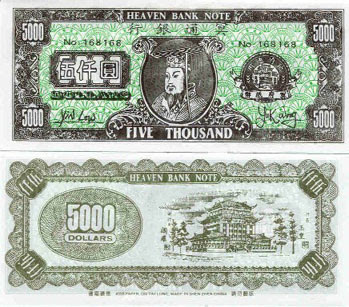Ma'at, Mot and Mort.
There is more than a phonetic connection between Ma'at, Mot and Mort.
Mort, from Latin Mors- is found in many English words connected with death: mortuary, remorse, mortal etc. Mort links the implacable, absolute nature of death with oaths and bonds through the word: mortgage- literally a death pledge and a sense of it is preserved in the marriage vows of the Christian church, "till death do us part".
The association between breaking an oath and death rests on an idea of justice as a restoration of fairness, of payback. In the now English word mort, there is a sense of misfortune arising from breaking a promise, but the misfortune is most likely going to be legal, rather than divine, and can be paid off.
Egyptian Ma'at, a goddess of justice, isn't usually connected with death. But she rides the Solar barque at sunset and provides a feather to weigh against the heart of the deceased. On the other hand, Canaanite Mot, is death incarnate, though he is rarely associated with justice.
More curiously though, in the stories of Ma'at and Mot there are themes of abductions, drownings in great rivers, a devouring wind, the grinding of bodies like wheat, and the winnowing of the remains, leading me to think of Demeter and Triptolemos- child of the thrice ploughed field- and John Barleycorn, Dumuzi/ Tammuz/Adonis and of course Persephone and Ereshkigal.
The function of justice in the stories of Ma'at and Mot is to re-balance and maintain the universe. This idea rests firmly on a belief that right and wrong are absolutes. Wrong-doing is punished to maintain order, as in the Christian idea of punishment by hell-fire, or reward in Heaven, and purgatory as a place to atone for bad deeds. This is taken as something so obvious that people have forgotten to ask why and how the order of the universe could be upset by injustice. We understand justice to be of paramount importance for society, but most of us fail to find any convincing link between justice on earth and the furnace of stars, or the pull of gravity, let alone the failure of crops to grow, until we start to think of carbon, global warming and cities drowning under Arctic melt-water.
The Egyptian goddess Ma'at set the order of the universe from chaos, at the moment of creation. She guards and personifies the correct order of things. She is harmony, justice, and truth. Cyclic festivals of restoration, of Ma'at were performed such as the Sed (the Feast of the Tail), or when ever crisis threatened stability.
In Ancient Egypt, stability was the king.
Ma'at seems to be at home in the Underworld. In the older Egyptian 'books of the dead' engraved on sarcophagi, or on tomb walls, Ma'at rode with the deceased in the solar sun-ship, 'the boat of millions'. In latter books drawn upon papyrus for wealthy clients, Ma'at provided the feather against which the heart of the deceased were weighed in a balance set up in the Hall of Two Truths.
All well and good, and pretty easy to understand, until we read that the "The Assessors of Maat" are 42 deities listed in the Papyrus of Nebseni, to whom the deceased make their Negative Confession. The Papyrus of Ani describes the 42 as "the hidden Maati gods, who feed upon Maat during the years of their lives;"
This is usually understood to mean that they are the righteous minor deities who deserve offerings. Yet the metaphor is of feeding from justice.
This idea is preserved and rationalized in 2 Corinthians 9:10.
But Mot seems to be death as an implacable, irresistible force for order, rather than death as an enemy of mankind.
This is shown in the story of Baal.
Baal, in Ugaritic myth is the Lord of Ugarit- lord of the World. And Baal is a deity accused of destroying the correct order of things as established by the elder god, El.
El, angered by Baal's behaviour chooses the sea, Prince Yamm to do battle with Baal, hoping that the sea will wash him away.
Instead, the sea is conquered and destroyed:
Baal is worried, but still believes that there is a way out.
He plans to trick Mot.
Following the advice of the sun goddess, Baal finds a substitute family to live in his palace to trick Mot into taking the wrong man. Then he takes his servants and daughters to hide in the only place Mot would not expect to find them.
The Underworld.
But of course, this means that Baal is now dead. Because going into the Underworld is not something one can play at. It is the place of ultimate order as Inana found out.
The world is now a dead place.
Nothing grows.
Nothing gives birth.
Anat, Baal's sister searches for Baal and finds Mot
In English, any connection between Roman mors and farming has gone. Only justice in the form of contracts and law, remains. But in the stories of Ma'at and Mot we have something older.
To quote William Robertson Smith:
It is a strange idea, but it feels as if inherent in the stories of Ma'at and Mot is the idea that eating cultivated grain makes a person righteous, that righteousness is union with the spirits of order and justice contained within cultivated crops.To go back even further, perhaps in these stories we hear echoes of pride, disguised as a belief in the correctness of farming as the border lines and boundaries are being fixed in place by Neolithic pioneers partitioning land that had once been free for all to use, providing resources for the Mesolithic hunters and traders.
If this is the case, then echoes of Neolithic culture still bounce around religious celebrations such as the Tsok puja and the Eucharist .
Mort, from Latin Mors- is found in many English words connected with death: mortuary, remorse, mortal etc. Mort links the implacable, absolute nature of death with oaths and bonds through the word: mortgage- literally a death pledge and a sense of it is preserved in the marriage vows of the Christian church, "till death do us part".
The association between breaking an oath and death rests on an idea of justice as a restoration of fairness, of payback. In the now English word mort, there is a sense of misfortune arising from breaking a promise, but the misfortune is most likely going to be legal, rather than divine, and can be paid off.
Egyptian Ma'at, a goddess of justice, isn't usually connected with death. But she rides the Solar barque at sunset and provides a feather to weigh against the heart of the deceased. On the other hand, Canaanite Mot, is death incarnate, though he is rarely associated with justice.
More curiously though, in the stories of Ma'at and Mot there are themes of abductions, drownings in great rivers, a devouring wind, the grinding of bodies like wheat, and the winnowing of the remains, leading me to think of Demeter and Triptolemos- child of the thrice ploughed field- and John Barleycorn, Dumuzi/ Tammuz/Adonis and of course Persephone and Ereshkigal.
The function of justice in the stories of Ma'at and Mot is to re-balance and maintain the universe. This idea rests firmly on a belief that right and wrong are absolutes. Wrong-doing is punished to maintain order, as in the Christian idea of punishment by hell-fire, or reward in Heaven, and purgatory as a place to atone for bad deeds. This is taken as something so obvious that people have forgotten to ask why and how the order of the universe could be upset by injustice. We understand justice to be of paramount importance for society, but most of us fail to find any convincing link between justice on earth and the furnace of stars, or the pull of gravity, let alone the failure of crops to grow, until we start to think of carbon, global warming and cities drowning under Arctic melt-water.
The Egyptian goddess Ma'at set the order of the universe from chaos, at the moment of creation. She guards and personifies the correct order of things. She is harmony, justice, and truth. Cyclic festivals of restoration, of Ma'at were performed such as the Sed (the Feast of the Tail), or when ever crisis threatened stability.
In Ancient Egypt, stability was the king.
Ma'at seems to be at home in the Underworld. In the older Egyptian 'books of the dead' engraved on sarcophagi, or on tomb walls, Ma'at rode with the deceased in the solar sun-ship, 'the boat of millions'. In latter books drawn upon papyrus for wealthy clients, Ma'at provided the feather against which the heart of the deceased were weighed in a balance set up in the Hall of Two Truths.
All well and good, and pretty easy to understand, until we read that the "The Assessors of Maat" are 42 deities listed in the Papyrus of Nebseni, to whom the deceased make their Negative Confession. The Papyrus of Ani describes the 42 as "the hidden Maati gods, who feed upon Maat during the years of their lives;"
This is usually understood to mean that they are the righteous minor deities who deserve offerings. Yet the metaphor is of feeding from justice.
This idea is preserved and rationalized in 2 Corinthians 9:10.
And [God] Who provides seed for the sower and bread for eating will also provide and multiply your [resources for] sowing and increase the fruits of your righteousness [[a]which manifests itself in active goodness, kindness, and charity].In Canaan, there is no little doubt that Mt is a word that means death.
But Mot seems to be death as an implacable, irresistible force for order, rather than death as an enemy of mankind.
This is shown in the story of Baal.
Baal, in Ugaritic myth is the Lord of Ugarit- lord of the World. And Baal is a deity accused of destroying the correct order of things as established by the elder god, El.
El, angered by Baal's behaviour chooses the sea, Prince Yamm to do battle with Baal, hoping that the sea will wash him away.
Instead, the sea is conquered and destroyed:
Baal...strikes the head of Prince [Yamm],/ Between the eyes of Judge river/ Yamm collapses and falls to the earth,/ His joints shake,/And his form sinks,/Baal drags and dismembers (?) Yamm,/He destroys Judge river (Smith 1994, p.323)Baal is intent upon establishing his New Order, symbolised by building his temple. But he wont have any windows put in, possibly because of the belief that Mot (death) comes in through them (Coogan 1978). But Baal is not so scared, for he has conquered many cities and has no respect for the Old Order Mot represents, so he refuses to pay any tribute to Mot, and finally challenges him. Mot reminds Baal that by conquering the sea he has 'caused a cosmic collapse' (Coogan 1978, p82) and the punishment for such a crime is death.
Baal is worried, but still believes that there is a way out.
He plans to trick Mot.
Following the advice of the sun goddess, Baal finds a substitute family to live in his palace to trick Mot into taking the wrong man. Then he takes his servants and daughters to hide in the only place Mot would not expect to find them.
The Underworld.
But of course, this means that Baal is now dead. Because going into the Underworld is not something one can play at. It is the place of ultimate order as Inana found out.
"Be satisfied, Inana, a divine power of the underworld has been fulfilled. Inana, you must not open your mouth against the rites of the underworld."
Then Ba'al does depart and tarry not;
He sets his face toward El's Beloved, Mot,
in the midst of his city, Hamriya, the Bog,
Down into the pit where is the low throne that he sits on,
to the filth of the earth, which is Mot's estate.
One lip to the earth, one lip to the heavens, Mot stretches tongue to the stars.
Ba'al enters his maw and descends into his mouth,
like olive stuffed bread, Like the produce of earth, the fruit of the trees.
Mot makes him like a lamb in his mouth,
like a kid in his gullet is Ba'al crushed and swallowed.
Then Ba'al returns not to his palace,
Mighty Rider of Clouds comes not back...link.
The world is now a dead place.
Nothing grows.
Nothing gives birth.
Anat, Baal's sister searches for Baal and finds Mot
She grabs/seizes divine/son of the El, Mot; with bladeMot like Ma'at, can now be eaten.
she does cleave/split him, with fan/sieve she does winnow
him, with fire she does burn him,
with hand-mill/mill-stone she grinds him, in the field
she does sow/scatter him, his remnants/pieces indeed devoured
by birds, his limbs/parts/portions indeed consumed
by fowl.
In English, any connection between Roman mors and farming has gone. Only justice in the form of contracts and law, remains. But in the stories of Ma'at and Mot we have something older.
To quote William Robertson Smith:
Religion did not exist for the saving of souls but for the preservation and welfare of society, and in all that was necessary to this end every man had to take his part, or break with the domestic and political community to which he belonged.
It is a strange idea, but it feels as if inherent in the stories of Ma'at and Mot is the idea that eating cultivated grain makes a person righteous, that righteousness is union with the spirits of order and justice contained within cultivated crops.To go back even further, perhaps in these stories we hear echoes of pride, disguised as a belief in the correctness of farming as the border lines and boundaries are being fixed in place by Neolithic pioneers partitioning land that had once been free for all to use, providing resources for the Mesolithic hunters and traders.
If this is the case, then echoes of Neolithic culture still bounce around religious celebrations such as the Tsok puja and the Eucharist .



